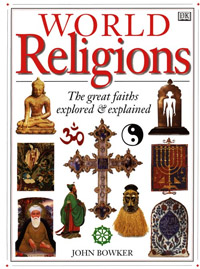By John Bowker
 Over the past few years, I’ve come to appreciate
the distinctive publishing style of DK. Their books are known for their
short nuggets of information laid out around creative photos and graphics.
Reading a DK book is akin to perusing the front page of USA Today. As
with USA Today, a case can be made that much in-depth information is
left out this way, but a better case cites the large number of people
who otherwise wouldn’t have even gotten these basics. DK artwork
is invariably beautiful, and the books are a graphic designer’s
dream, especially in this book’s large format.
Over the past few years, I’ve come to appreciate
the distinctive publishing style of DK. Their books are known for their
short nuggets of information laid out around creative photos and graphics.
Reading a DK book is akin to perusing the front page of USA Today. As
with USA Today, a case can be made that much in-depth information is
left out this way, but a better case cites the large number of people
who otherwise wouldn’t have even gotten these basics. DK artwork
is invariably beautiful, and the books are a graphic designer’s
dream, especially in this book’s large format.
Each religion here is presented in only a few pages, with each huge
spread (the book is an enormous 10” by 15”) covering a narrowed
topic, such as the religion’s history, the life of its founder,
the different sects, or its rituals. The faiths follow chronologically,
from ancient religions (Norse, Greek, Egyptian, and Zoroastrianism) to
Hinduism, Jainism, Buddhism, Sikhism, and Chinese and Japanese religions,
and on to the Western tradition of Judaism, Christianity and Islam, with
some “native” religions thrown in for good measure. I felt a section on “modern religions” to match the “ancient
religions” would have been appropriate. This absence is particularly
odd since another DK religion book I’ve seen is a smaller version
of this one, and includes several great pages on the Baha’i Faith.
I found Jainism and Sikhism the most interesting sections, but probably
only because I knew the least about them going in. The book’s strongest
point is probably China and Japan. It does a good job of explaining how
Shintoism in Japan, and Taoism and Confucianism in China, interact with
Buddhism. Oddly enough, I felt the book’s strength in multiculturalism
negatively affected the section on Christianity, which I felt was too
short. The section on Judaism, for example, was as long as Christianity’s,
though there are many more Christians and thus, many more sects of Christianity
to explain. The history and tenets of both Christianity and Islam were
presented well, but details on their splintered groups were lacking.
The Sufi tradition is covered, but there is no mention of Wahhabism,
nor distinct Christian groups like Pentecostals or Mormons.